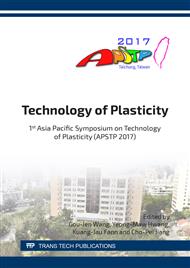p.187
p.193
p.199
p.205
p.211
p.217
p.223
p.230
p.236
Characterizing of Anisotropy and Asymmetry of Tubular Materials
Abstract:
Titanium tubular materials with high strength, long-lifetime and light weight has attracted wide attention in many industries such as aerospace, energy and chemistry. While, titanium tubular materials are subjected to complex multiple thermal-mechanical processing, and generally present pronounced anisotropy/asymmetry properties, which greatly affects the formability and the performance of the tubular materials. Meanwhile, thin-walled tubular materials are difficult-to-characterizing materials. Thus, how to accurately and comprehensively characterize the mechanical properties is the most vital issue and precondition for innovative design of the fabricating and forming of the tubular materials and components. However, the hollow structure of tubular materials, especially thin-walled geometry, makes the testing and characterizing of the mechanical properties a challenge. In this research, a general testing and characterizing framework is developed to determine anisotropic and asymmetrical mechanical properties for tubular materials. In the framework, Knoop microhardness is first employed to qualitatively identify anisotropy and asymmetry of titanium tubes. The basic tension and compression mechanical properties along axial direction are determined by mean of uniaxial tensile and compressive tests. Combined with tension and compression tests, the viscoplastic self-consistent crystal plasticity (VPSC) is calibrated to complement the deformation behaviors along other different loading directions. Taking Ti-3Al-2.5V titanium tube and commercial pure titanium (CP-Ti) tube as the case materials, the application of the above framework for the mandrel bending demonstrates the feasibility of the proposed methodology.
Info:
Periodical:
Pages:
211-216
Citation:
Online since:
April 2018
Authors:
Price:
Сopyright:
© 2018 Trans Tech Publications Ltd. All Rights Reserved
Share:
Citation:


